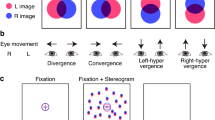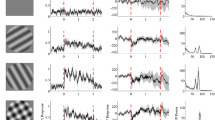Abstract
IT is known that within the visual pathway of the brains of anaesthetized animals single units can be found which respond optimally when both eyes are simultaneously stimulated with light1–3. The characteristics of such binocular units are consistent with psychophysically observed features of binocular depth perception4–6. At present, human subjects have important advantages over animals in studies of stereopsis because with human subjects the critical binocular fusion and subjective reports of depth perception can easily be obtained. With human subjects, however, any electrophysiological information must be obtained by the analysis of scalp evoked potentials (EPs). This communication reports the finding of an EP correlate of binocular depth perception in man.
This is a preview of subscription content, access via your institution
Access options
Subscribe to this journal
Receive 51 print issues and online access
$199.00 per year
only $3.90 per issue
Buy this article
- Purchase on Springer Link
- Instant access to full article PDF
Prices may be subject to local taxes which are calculated during checkout
Similar content being viewed by others
References
Hubel, D. H., and Wiesel, T. N., J. Physiol., 160, 106 (1962).
Hubel, D. H., and Wiesel, T. N., J. Neurophysiol., 26, 994 (1963).
Hubel, D. H., and Wiesel, T. N., J. Physiol., 195, 215 (1968).
Barlow, H. B., Blakemore, C., and Pettigrew, J. D., J. Physiol., 193, 327 (1967).
Nikara, T., Bishop, P. O., and Pettigrew, J. D., Exp. Brain Res., 6, 353 (1968).
Pettigrew, J. D., Nikara, T., and Bishop, P. O., Exp. Brain Res., 6, 391 (1968).
Julesz, B., Bell System Tech. J., 32, 1125 (1960).
Julesz, B., Sci. Amer., 212, 38 (1965).
MacKay, D. M., and Rietveld, W. J., Nature, 217, 677 (1968).
Spekreijse, H., thesis, Univ. Amsterdam (1966).
Regan, D., Electroenceph. Clin. Neurophysiol., 25, 231 (1968).
Tweel, L. H. van der, and Spekreijse, H., Ann. NY Acad. Sci., 156 (1969).
Tweel, L. H. van der, and Verduyn Lunel, H. F. E., Electroenceph. Clin. Neurophysiol., 18, 587 (1965).
Regan, D., Perception and Psychophysics, 4, 347 (1968).
Author information
Authors and Affiliations
Rights and permissions
About this article
Cite this article
REGAN, D., SPEKREIJSE, H. Electrophysiological Correlate of Binocular Depth Perception in Man. Nature 225, 92–94 (1970). https://doi.org/10.1038/225092a0
Received:
Issue Date:
DOI: https://doi.org/10.1038/225092a0
This article is cited by
-
Stereoscopic acuity in ocular pursuit of moving objects
Documenta Ophthalmologica (1991)
-
Dynamic stereoacuity: A comparison of electrophysiological and psychophysical responses in normal and stereoblind observers
Documenta Ophthalmologica (1988)
-
Topographical study of stereo-related potentials
Documenta Ophthalmologica (1987)
-
Electrophysiological assessment of the human depth-perception threshold
Graefe’s Archive for Clinical and Experimental Ophthalmology (1987)
-
Critical analysis of visual function evaluating techniques in newborn babies
International Ophthalmology (1985)
Comments
By submitting a comment you agree to abide by our Terms and Community Guidelines. If you find something abusive or that does not comply with our terms or guidelines please flag it as inappropriate.



